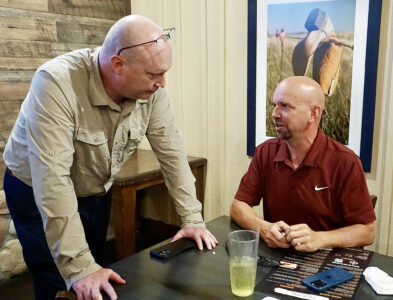1936: Coldest winter ever
PARSHALL All records are made to be broken. That well known axiom may be true, but it is hard to believe that anyone is earnestly hoping to surpass what happened in this community in 1936.
It was on this date, Feb. 15, in 1936, that the temperature dropped to a ridiculously frigid and frighteningly cold minus 60 degrees on the Farenheit scale in downtown Parshall. That a thermometer even existed in Parshall to record such a low temperature is equally remarkable. Mercury thermometers, the most common of the day, couldn’t record such a reading because mercury becomes a solid at -37.89 degrees.
However, says Richard Krolak of the National Weather Service in Bismarck, the -60 reading is accurate and remains a North Dakota record for frigid futility.
“The -60 reading was taken right in Parshall,” said Krolak. “It had to have been done with a special thermometer, liquid in glass, good to -69. It would have been housed in a shelter.”
Krolak is a meterological technician who directs co-operative weather observers and oversees data collection at the Bismarck bureau of the NWS. When asked a series of questions by the Minot Daily News, Krolak became intriqued as to how and where the -60 reading was recorded. He checked old NWS records and found the -60 reading on a hand-written sheet that a NWS co-op observer filled out and mailed to the Bismarck office at the end of February 1936.
“This one was very, very sketchy,” said Krolak. “There was no first name on the report. Just a last name, Shubert. He was a coal miner, evidently. That’s what the station history said.”
An August 1976 story in the Minot Daily News on Court Shubert says he arrived in Parshall on the first train to stop there in 1915. In 1930 he volunteered to be a weather observer for the NWS. The 1976 account noted that Shubert was honored for 45 years of service as a weather observer and confirmed he was the man who took the -60 reading in 1936.
Information held by the NWS from that time period includes serial numbers of equipment and location of observations, usually by longitude and latitude. However, there were no such coordinates on Parshall’s monthly report for Feb. 1936. It was originally speculated that the reading must have been made at a farmstead south of the city, but Krolak says evidence has come to light that the reading was made in Parshall proper.
The thermometer used to record the state’s all-time low was issued by the NWS and contained a mercury-thallium alloy such as those thermometers used in places where severe cold is common, like Siberia. Mercury-thallium alloy thermometers don’t freeze until the temperature reaches -78 Farenheit.
Perusing old records, Krolak was able to discover the longitude and latitude coordinates for Parshall’s co-op weather site where the record low temperature was recorded. The reading was taken by an NWS co-operative observer identified in NWS monthly reports only as Shubert.
“Information on that site is very, very sketchy. There was no first name on the monthly reports, just a last name signature,” said Krolak. “He was a coal miner. That’s what the station history says.”
The longitude and latitude coordinates supplied by the NWS places the site of the reading near where Average Joe’s Bar is on Main Street in Parshall today. According to Krolak, the special mercury-thallium alloy thermometer would have been housed in a Cotton Region Shelter. The small shelters were mounted on a metal frame which placed them about eye-level. Although there is no evidence remaining of the Cotton Region Shelter used in Parshall in 1936, many such shelters remain in use today.
Parshall’s dubious record for futility has held for 80 years without a serious challenge. There are very few Parshall residents from that time who are alive today. One who remains is Joseph Holt, who would only tell the Minot Daily News that he’s in his 80’s. Holt was too young at the time of the record to recall that frigid day, but he remembers people talking about it as he grew up.
“That’s about it. I do remember them talking about it. I just remember that,” said Holt.
The record has held for 80 years, but can such a mark for futility also be a claim to fame for Parshall, a source of pride for the community? There is no plaque to commemorate the site or glorify the date. Is that just an oversight or a purposely forgotten moment of history?
“Most people don’t even want to know about that one,” said Richard Balkin, former mayor of Parshall.
Parshall’s ludicrously low reading of -60 was not simply a weird daily phenomenon. The winter of 1936, particularly February, had the nastiest temperatures ever recorded in the state. On the day Parshall hit -60 Minot recorded its all-time record low of -49 degrees.
Many North Dakotans are familiar with -20, even -30, but -60 is another matter entirely. That type of cold, miserably bitter cold, is seldom experienced anywhere but in the coldest regions of the world. Even in Fairbanks, Alaska, a region well known for frigid weather, -60 is big news.
“During the last 35 years it has not been -60 here,” said John Lingaas, NWS Warning Coordination Meteorologist in Fairbanks. “During our low temperature period in December and January it can be -40 every single hour of the day.”
“Once you get to 30 below what does it matter? I don’t see anything working,” remarked Krolak.
Certainly getting vehicles to start and run at -60 would have been very challenging to Parshall residents. In Alaska, vehicle owners often use both an engine block heater and an electric battery blanket to assist with starting in sub-zero temperatures. Some add a heating pad underneath the oil pan was well. None of those options would have been available in 1936.
Horses, and the only mercury-thallium thermometer in town, may have been about all that was working in the region during the miserable winter of 1936, especially in February. According to the Minot Daily News most roads in the region were impassable due to drifting snow.
Of particular concern in almost every community was the rapidly dwindling supply of coal, the most common method of heating at the time. Trucks couldn’t get to or from area coal mines due to snow-choked roads and bitter cold. The situation became so dire that many farmers were forced to tear down sheds and garages and use the wood to heat their homes and keep family members from freezing. In South Dakota it was reported that miles of fence was torn down so that the wooden posts could be burned as heating fuel. The cold snap was vicious, lethal and widespread.
The Minot Daily News reported on Feb. 14, the day prior to the worst of the cold, that the thermometer tumbled to -40 in Devils Lake, -38 in Minot and -37 in Dickinson. Furthermore, it added, “Storms churned the Atlantic, menacing ships from the Canadian coast to Spain and sending Coast Guard cutters thru blinding snow on rescue missions.”
Hearty residents somehow managed to cope with the cold, but they had no choice. Mixed in with the stories of coal shortages and record temperatures was a question of great interest at City Hall, can dancing and beer be allowed under the same roof? The city attorney ruled it illegal. It’s likely that matter received less attention from residents than it might have if the weather had been warmer. For many, the record cold turned ordinary life into a matter of survival. Beer and dancing could wait.
Cruelly, the wicked cold spell wouldn’t let up. Four states North Dakota, South Dakota, Minnesota and Iowa had their coldest winter on record. The statistics are numbing. The average temperature in Devils Lake for a five-week period ending Feb. 21, 1936 was -21. McIntosh, S.D., hit -58, Jordan, Mont. -60 and Sceptre, Sask., -63.
A meteorologist in Iowa said that February 1936 was the “longest and coldest” stretch of weather in 117 years. The proof was everywhere. 1936 saw Minot set 7 all-time low temperatures for February. Those records remain today.
The day Parshall hit -60 and Minot -49 there were numerous other reports of sub-zero readings too. From the “Denbigh Dunes Forest” the chemist in charge of soil surveys, Leroy C. Baskin, came a reading of -56. Willow City and McClusky reported -53. Crookston, Minn., reached -51, Devils Lake and Dickinson -46 and Williston -44.
A sickening and heart-wrenching story emerged about a Manitoba man traveling by bus. He wanted to take his dog on board with him but was told it was against company policy. The driver consented to putting the dog in the luggage compartment. The poor animal was discovered frozen solid at the first stop on the route. The temperature was -36.
During the same time period Plentywood, Mont., checked in with their all-time low of -58, also a Montana record. Crosby reported the thermometer climbed all the way up to -31, the warmest day in a week.
When the weather finally broke just a bit and some of the roads began to be cleared enough to allow passage of trucks and other vehicles, North Dakotans breathed a huge sigh of relief. One of the first acts of recovery was to open roadways so that those trucks that could be started could reach nearby coal mines. One can only imagine the happy reception for trucks bringing 125 tons of coal in Parshall to replenish empty bins.
The Minot Daily News reported on Feb. 17, 1936, that “the cold spell that has brought sub-zero weather for 46 days will hold sway” for a few more days. According to the NWS Minot averaged 32 degrees below normal throughout February 1936. Relief came in the form of temperatures ranging from -10 to -20, or 50 to 60 degrees less than what the Minot area has been experiencing this winter.
The record lows occurred during the period known as the “Dirty 30’s”, or the Dust Bowl era. Meteorologists say that dry conditions likely were responsible for the record cold. A few months later Steele, ND, experienced the highest temperature ever recorded in this state when the thermometer climbed to 121 degrees on July 6, 1936, truly the most remarkable year for weather in the recorded history of North Dakota.



